Lately, Yu Darvish has been really good. This is notable for a simple reason: It’s been quite a while since Darvish has been really good. I will be the first to admit that I had given up on Darvish early on in the year. Not only had I given up on him for this year, but I thought he was toast—permanently. All year, Nick Pollack’s (what I perceive to be) steadfast belief in Darvish has, overall, not wavered as much as I think it should have, and I could never figure out why. For a chunk of the year, Darvish was striking a lot of hitters out, but his fastball velocity was gone, and his walks and home runs allowed were up too. Well, more recently, he’s really started to hit his stride.
Since July 12th, Darvish is on a run that is…well, bananas. Over 55.1 innings, he’s struck out 72 batters while walking just three. That translates to an elite 33.6 K%, 1.4 BB%, and 32.2 K-BB%. This is perhaps due in part to Darvish changing his release timing, and he’s also switched out his slider for a more controllable cutter.
Here, The Athletic’s Eno Sarris compares Darvish’s Command+ and release point:
This is what I got. Better release point, slightly different pitching mix, better command. https://t.co/3mSYvz8Quf pic.twitter.com/AnvpoZ2AEN
— Eno Sarris (@enosarris) August 16, 2019
As you can see here, Darvish has had below-average command throughout the year. More recently, he’s hit his stride and had, more or less, average command since July 12th—and it’s still improving! The results have been fantastic, aside from one thing: dingers. Even since his hot streak, Darvish has had a three-homer and four-homer game, which has caused his 3.62 FIP since July 12th to be incongruent from his 2.93 ERA, 2.84 xFIP, and 2.74 SIERA.
While three of the metrics support an elite Darvish, what they’re more or less ignoring are the home runs and quality of contact. There are a few things we’re going to want to look at.
First, let’s look at location. Through July 3rd, Darvish’s overall location slider and cutter location:
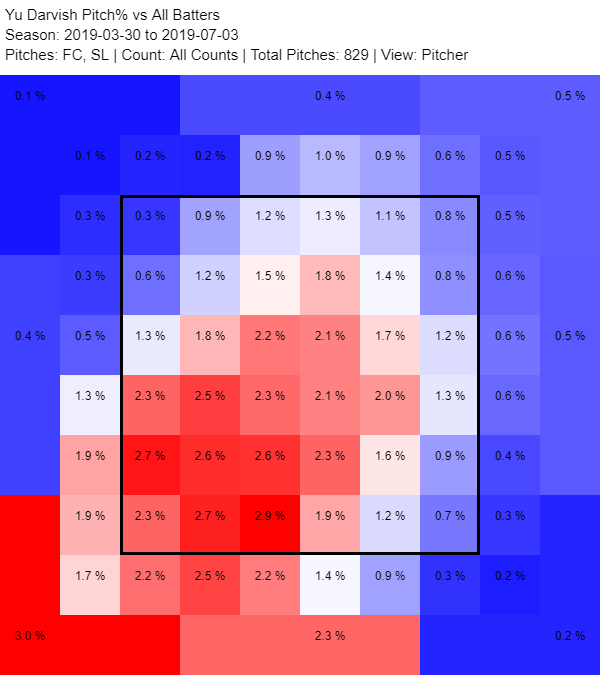
This looks fine, right? Well let’s look at Darvish’s slider and cutter location since July 12th:
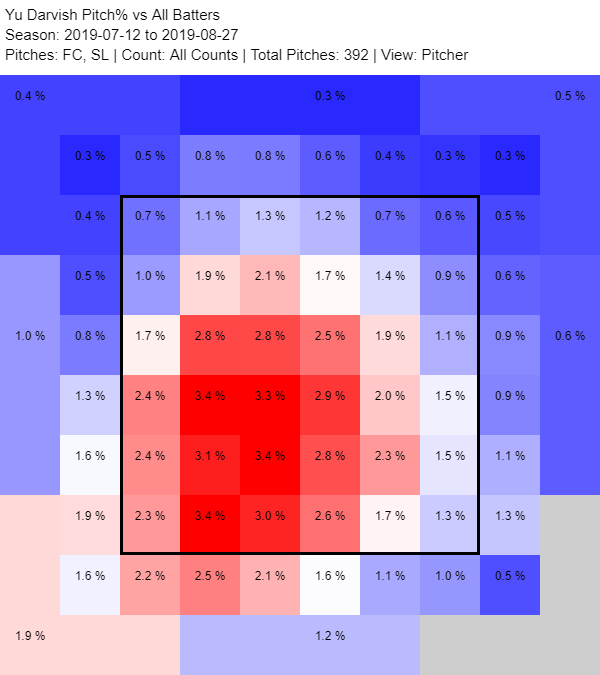
Overall, it’s pretty similar, but there’s a very clear aggregation of pitches in the zone, relative to before. I’m not the only one to notice this. This is basically what Devan Fink wrote, just in another form. What Darvish is done is make a trade-off, as Fink put it, to throw a more controllable cutter in place of his slider.
It’s caused his overall zone-percentage to skyrocket:
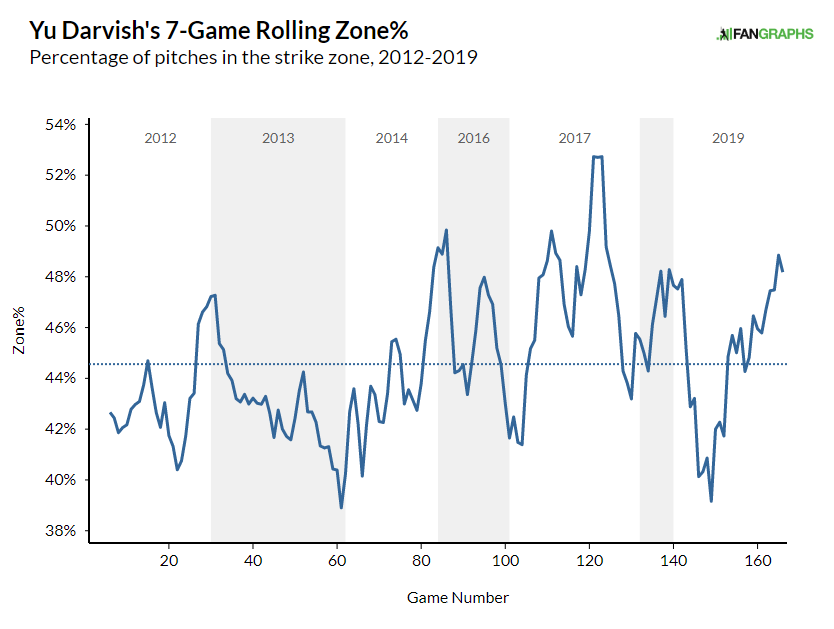
So, while that’s helped to ameliorate his struggles in terms of walks, it hasn’t completely solved his home run woes. Next, let’s look at quality of contact. Allow me to barrage you with a swarm of numbers:
Through 7/3 xwOBA on FB/LD: .641
From 7/12, xwOBA on FB/LD: .585
Through 7/3, xBA on home runs: 0.777
From 7/12, xBA on home runs: 0.672
Through 7/3, avg exit velo on home runs: 105.3
From 7/12, avg exit velo on home runs: 102.8
Through 7/3, max exit velo on home runs: 111.5
From 7/12, max exit velo on home runs: 106.6
Through 7/3, avg distance on home runs: 408 ft
From 7/12, avg distance on home runs: 398 ft
So, by these numbers—and they could be biased—we’re seeing some improvements from Darvish. Through July 3rd, Darvish has a HR/9+ of 136 (95th percentile), while from July 12th, his HR/9+ is 138 (85th percentile). Maybe he’s improved in the home run department, and maybe he hasn’t. However, we do want to add some very important context here. Since his August 15th start, Darvish’s fastball velocity has been steadily declining. Importantly, his four-homer game came during that run, when his average fastball velocity was the lowest it’s been since June 21st. Make of it what you will, but I’m not convinced that this is a coincidence.
All of this information leads up to this: Darvish might be adding a new wrinkle. In my last article, I noted how Joe Kelly has a Craig Kimbrel-esque fastball-curveball tandem. As it turns out, Darvish has a newfound similarity to Kimbrel. Let’s take a peek at some of Darvish’s pitches from the other night.
Here, you can see Darvish’s pitches by horizontal and vertical movement:

Here, everything seems to be in order. For the most part, everything looks as it usually does. That is, by movement.
Let’s look at Darvish’s pitches again. This time, by vertical movement and velocity:
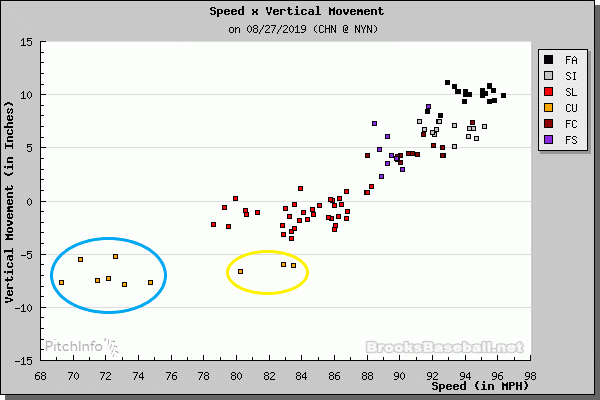
I’ve highlighted Darvish’s curveballs in blue again. But this time, something is new: as you can see circled in yellow, he threw a few curveballs far harder than usual.
From Jordan Bastian:
Darvish said he got two strikeouts with his new knucklecurve tonight. Yu: “Kimbrel taught me that a week ago.”
— Jordan Bastian (@MLBastian) August 28, 2019
Darvish has another pitch now. More importantly, an effective new pitch. It’s not like Darvish had a dearth of options—he had nine distinct offerings, but now he has ten meaningfully distinct pitches. Along with his other pitches, he has a slow curveball, his regular curveball, and now a harder knuckle-curve.
Here’s a knuckle curve, resulting in a swinging strikeout:
https://gfycat.com/finecookedhamster
Velocity? 83 mph.
Here’s another knuckle curve, yielding yet another swinging strikeout:
https://gfycat.com/yellowishforthrightaustralianshelduck
Velocity? 82 mph.
Lastly, his third (and last) knuckle curve, that does not get Amed Rosario to whiff:
https://gfycat.com/biodegradablegreatgemsbok
Velocity: 79 mph. Not as sharp as the other two, and far more hittable by location, too. Rosario gets his bat on the ball, but he drives it into the ground for a groundout. This is perhaps evidence that Darvish could stand to gain greater feel for the pitch, but it’s hard to complain about a pitch that created an out. Especially one that he just learned.
What is peculiar, though, is no one is talking about the Darvish’s prior start against the Giants: He had already been using this knuckle curve.
From Cubs manager Joe Maddon:
“He was throwing a knuckle curve [Wednesday] night. He felt it in the bullpen and broke it out in the game.
Wednesday night isn’t the 27th, his start against the Mets. It’s the 21st, which was against the Giants, and it seems it was overlooked.
Notice the bump in maximum curveball velocity:
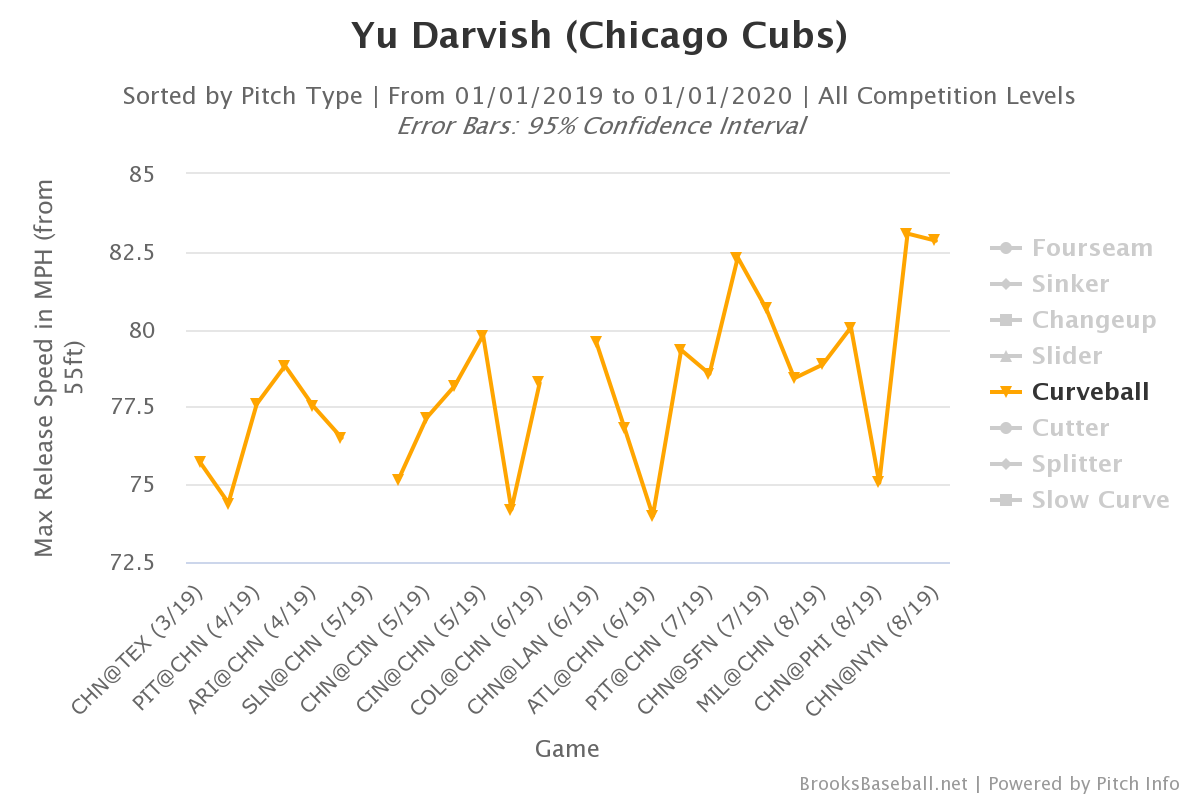
As well as the same velocity and vertical movement profile displayed in his most recent game, circled in red:
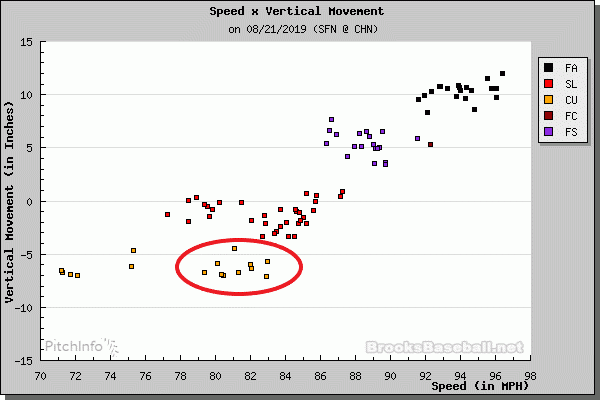
So, while we all missed it, it seems as if Darvish learned a new pitch grip and used it in the same night. It’s hard to say in words how ridiculous that is, if it’s true. It’s awfully impressive, and although things did not go perfectly, you wouldn’t expect them to. Let’s take a look at a few of his knuckle curves, this time, against the Giants.
There was great:
https://gfycat.com/ancientdismalamphibian
There was good:
https://gfycat.com/piercingillinformedermine
There was okay:
https://gfycat.com/breakablecarefulkingfisher
And there was bad:
https://gfycat.com/jaggedyearlybarb
Clearly, this knuckle curve plays best when it has some bite and is below the zone. There’s still quite a bit of heterogeneity between his knuckle curves, but as he continues to throw it, that should get better. In any case, Darvish has shown that at it’s best, his knuckle curve is a great pitch. He just needs to lock in some consistency.
Seriously though, Victor Caratini wants the knuckle curve down:
Yu Darvish, Filthy 82mph Knuckle Curve. ? pic.twitter.com/NJ7PzJcm0Y
— Rob Friedman (@PitchingNinja) August 28, 2019
What we don’t want to get lost in the shuffle is that this is incredible. As fans, it may be easy to say, “Player X just needs to add a cutter” or “Player Y should start throwing splitter” but it’s not that simple. Pitchers need to be comfortable with their offerings. We’ve seen plenty of pitchers lose feel of their pitches (say, Edwin Diaz), and we’ve seen players regain their feel for their pitches too (we’re looking at you, Andrew Heaney). It’s difficult enough to have good pitches as is, but to tinker with pitches in the middle of the season and have success with them is somewhat unprecedented. Darvish has broken that precedent here.
Getting a new potential wipeout pitch is a pretty incredible windfall for Darvish, as he was already starting to perform as he hadn’t in years.
Darvish’s five-game rolling strikeout- and walk-percentage:

Now, clearly this is amazing. He’s essentially walked fewer hitters than ever lately, and he’s striking hitters out at a rate he mostly has not before. I want to be careful to not appear too starry-eyed here, though. First, this is a pitch he’s used in games just over a dozen times. His fastball velocity is plunging again, home runs are a problem, and he still doesn’t have the results on his sinker or four-seamer that we want, either. The hope is that his knuckle curve (a) turns into a weapon that he can turn to with confidence, and (b) helps his fastballs play up. Both are far from foregone conclusions, but neither are completely unrealistic either.
With this knuckle curve, Darvish now has every pitch he could possibly need. His sinker, changeup, and splitter both go arm-side, his cutter and slider go glove-side, and his knuckle curve is a hard pitch with tons of drop (to say nothing of his four-seam fastball and other curveballs). There’s one more change I’d like to see Darvish make.
Four-seam location, career:
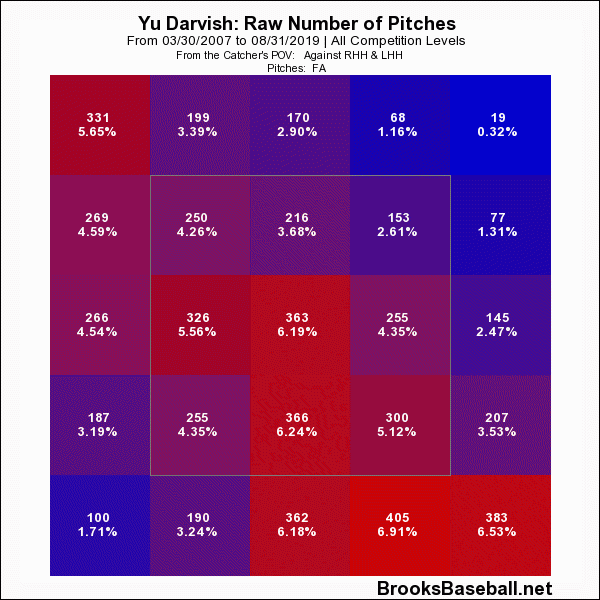
And four-seam whiff rate, career:
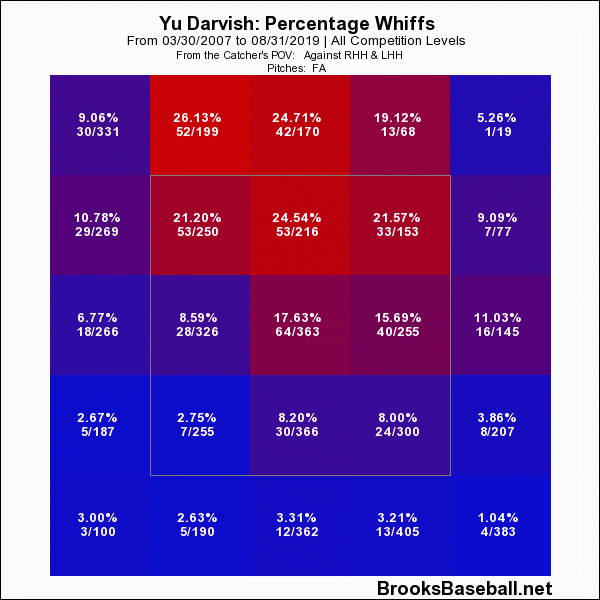
Quite the incongruence between location and whiffs, right? Darvish gets a crazy amount of whiffs when he elevates his fastball, and yet he has insisted on continuing to throw it to the vertical middle and below. You may be thinking about his declining fastball velocity—it’s not illogical to think that it doesn’t play as well elevated anymore. Well, with the spin he gets on his fastball, paired with his breaking stuff, this hasn’t changed.
Four-seam whiff rate, 2019:
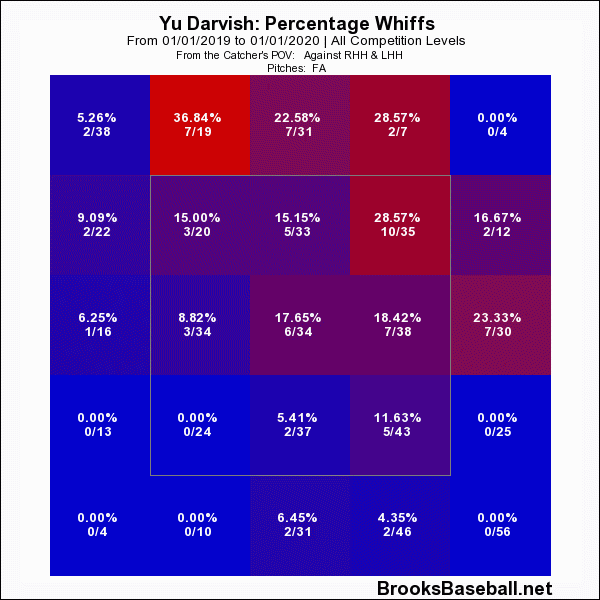
Other than fastball elevation (or, lack thereof, rather), Darvish is doing all of the right things. He’s (a) found a better release point, (b) turned to a cutter that he can command better than his slider, (c) altered his pitch mix to move away from the two pitches that he walks batters more than other (i.e., four-seam and sinker). I find these to all be judicious changes, and now, he’s got a new pitch to throw in the mix. He’s 33, so if he’s truly losing velocity, he’s still got the spin. His new knuckle curve doesn’t change the fact that he’s got two ineffective fastballs. But if he begins to elevate it, or if his knuckle curve takes flight, we could start to see an even better Yu Darvish. There’s a lot of different outcomes here—some good, some bad—but I see plenty of avenues for Darvish to return to sustained dominance.
(Photo by Dustin Bradford/Icon Sportswire)


Apparently forearm tightness is to blame for the dimished velocity recently. Cubs don’t seem worried as they skipped his start yesterday, but i am! I like this Darvish. I want more. Great article and here’s to Yu health!
Nice to have a reason for the dipping velocity. Just too bad it means it’s his forearm, which is a little scary. I like this Darvish too, though. Thanks!
Great in-depth article!
Here’s to hoping Darvish be back to his early 2010s form (a true ace)
Appreciate it!
I’m hoping he can get back to that too. The odds are against him because of age, but if anyone can do it, it’s someone with his repertoire and fastball spin.